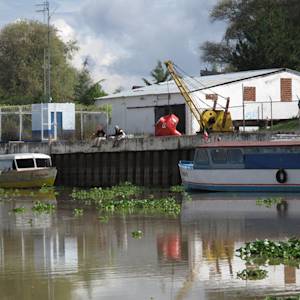Tama River
Personal memory by Miwako Tezuka
1965 • Kawasaki, Kanagawa Prefecture, Japan
I grew up right by a river. My family home was a few minutes walk from the riverbank. My grandfather, who also grew up in the same town in the same home for his entire life, was quite an amateur fisherman. He went river fishing all the time and often took me with him. My fuzzy memory from that time is an image of the water's edge, shining and silvery—from the bellies of many dead funa (a type of carp) floating and undulating with the current. It was a river in a city, just south of Tokyo, known at the time as one of the most heavily polluted in Japan. During the "economic miracle" of the 1960s-70s, metal and oil companies built their factories along the river and that led to population and domestic wastewater increase. But, as factories closed one by one in the neighborhood and various environmental regulations were set in place during the 1970s to the 1990s, the water started to clear up and the riverbank began to grow greens. Nowadays, fish swim, not float. Herons and kingfishers are often seen, too. It took well over three decades and the efforts of numerous townspeople for this change to come about. My grandfather is long gone, but there are, today, many fishing enthusiasts at the river.
"Tama River Sunrise Visit" by Flickr user Zhao !, Creative Commons 2.0


Learn about Maya Lin’s fifth and final memorial: a multi-platform science based artwork that presents an ecological history of our world - past, present, and future.

Discover ecological histories and stories of former abundance, loss, and recovery on the map of memory.

Learn how we can reduce our emissions and protect and restore species and habitats – around the world.

See how art can help us rethink the problems we face, and give us hope that each one of us can make a difference.

Help make a global memorial something personal and close to home. Share your stories of the natural world.

